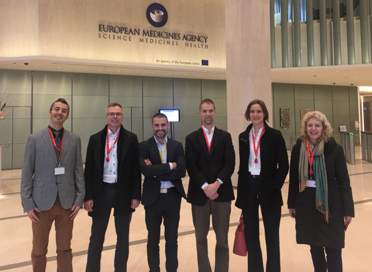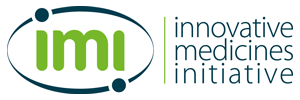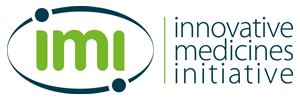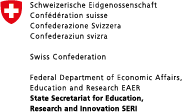Throughout the RHAPSODY project, we were in close contact with the European Medicines Agency (EMA), the Medicines and Healthcare products Regulatory Agency (MHRA), patient organisations, regulatory experts and health economists.
We discussed, with both the EMA and the MHRA, all relevant data related to the usefulness and reliability of novel blood biomarkers to monitor type 2 diabetes development and progression, with the ultimate goal of using them in clinical settings.
In this context, we developed and validated computer simulation models that are able to predict type 2 diabetes progression, plus those health benefits and costs needed to calculate long-term outcomes and develop scenarios for new treatment approaches. These tools have the potential to support decision making by European and UK agencies for the adoption and reimbursement of medicines in diabetes; all pertinent information was provided to both regulatory bodies in the form of a Briefing Book document.

As RHAPSODY was predominantly a European-based project, both the EMA and MHRA were the appropriate bodies to evaluate our new RHAPSODY biomarkers. The RHAPSODY regulatory team engaged for a second time with the EMA in May 2021.
At this second meeting, we presented scientific evidence obtained during the project to demonstrate the efficacy and reliability of our new biomarkers to stratify type 2 diabetic patients and their added value for diabetes prediction modelling.
The Medicines and Healthcare products Regulatory Agency (MHRA) is now the Regulatory Body of relevance in the United Kingdom, post-Brexit. Therefore, we also reached out to them with the view to receiving feedback on RHAPSODY biomarker discovery and validation efforts.
Both regulatory bodies offered similar guidance on how best to proceed with the next validation steps, namely that more focused investigations, such as clinical trials, would be needed. As such trials were never under the RHAPSODY remit, we are very pleased to have achieved all necessary steps prior to this.
For further information regarding regulatory steps for biomarker validation and qualification, please refer to these external sites:
- www.ema.europa.eu/en
- www.ema.europa.eu/en/predictive-biomarker-based-assay-development-context-drug-development-lifecycle
- www.ema.europa.eu/en/co-development-pharmacogenomic-biomarkers-assays-context-drug-development
- www.ema.europa.eu/en/ich-e16-genomic-biomarkers-related-drug-response-context-structure-format-qualification-submissions
- www.ema.europa.eu/en/methodological-issues-pharmacogenomic-biomarkers-relation-clinical-development-patient-selection

The RHAPSODY regulatory team prior to our Innovative Task Force meeting at the European Medicines Agency in London, 1st Feb 2017.
From left to right: N. Giordano (Uni. Lund), H. Ruetten (Sanofi), P. Franks (Uni. Lund), G. Rutter (Imperial College London), C. Charron (Janssen) and R. Adams (Janssen).
Why do we need to assess costs-benefits of precision medicine?
Precision medicine can have a positive effect on the clinical management of type 2 diabetes by reducing disease progression, and by addressing the specific needs of ‘clusters’ of patients at different stages of progression. In RHAPSODY, we have developed tools to compare the costs and health benefits of strategies for clinical management of type 2 diabetes based on precision medicine, throughout disease stages and type 2 diabetic ‘clusters’. Such an approach is known as economic evaluation. An economic evaluation helps to determine whether the extra costs involved in identifying patients with specific characteristics are worth the extra benefits provided by offering them a tailored treatment.

Which tools have been developed in RHAPSODY to support economic evaluation?
To support the evaluation of precision strategies for diabetes prevention by European agencies, we have developed a new prediabetes computer simulation model (the MICADO model) and fully integrated it into an existing validated computer model for type 2 diabetes (the UKPDS-Outcomes Model). Concurrently, we have validated both computer models for use in various European countries in order to predict type 2 diabetes progression, health benefits and costs. The validation of the models in European populations will facilitate their wide use while reinforcing their long-term predictions of costs and quality-adjusted life years (QALYs).
The ultimate goal is that the RHAPSODY biomarkers be used to improve clinical trial designs. RHAPSODY offers two potential strategies for using precision medicine in type 2 diabetic patients and we have developed tools to evaluate both. First, stratified treatment could be offered according to the ‘clusters’ identified by RHAPSODY scientists. Second, precision medicine could be offered based on the levels of a single ‘candidate biomarker’ or a combination of ‘candidate biomarkers’. After having defined possible treatment strategies for clusters with different levels of the ‘candidate biomarkers’, our validated computer models for type 2 diabetes can predict long-term health benefits and economic outcomes and inform opportunities for more targeted care. Better clinical trials will help bring new medicines to patients and hopefully improve their quality of life.
Papers on the cost-effectiveness of diabetes prevention strategies
We recently conducted a simulation exercise to estimate the maximum costs and minimum delay in onset needed for a hypothetical diabetes-delaying intervention to be cost-effective. Using the UKPDS Outcomes Model and data from the NAVIGATOR trial, we showed an intervention could cost up to £201 for a one-year delay and £947 for a nine-year delay and remain cost-effective in the UK. These results were published in Diabetes Care and will inform the ongoing debate about diabetes prevention strategies. Furthermore, our paper defined the framework to evaluate the potential value for money of translating the use of ‘candidate biomarkers’ into clinical practice. Learn more here.
Literature review of prediabetes computer models: what is still missing today?
We recently conducted a review of the literature on prediabetes computer models and their usefulness in informing precision medicine strategies. We showed considerable limitations in the quality of existing computer models. Our results were published in Diabetes, Obesity and Metabolism and highlight the clear need for more comprehensive prediabetes computer models. This work helped develop a new prediabetes computer model in RHAPSODY, capable of translating the impact of ‘candidate biomarkers’ on blood glucose into long-term costs and health benefits. Learn more here.
Clinical Data Interchange Standards Consortium. A set of widely used standards for clinical data.
A research study in which one or more human subjects are prospectively assigned to one or more interventions (which may include placebo or other control) to evaluate the effects of those interventions on health-related biomedical or behavioral outcomes (source: https://grants.nih.gov/).
Patient cohort: A group of individuals affected by common diseases, environmental or temporal influences, treatments, or other traits whose progress is assessed in a research study (source: https://medical-dictionary.thefreedictionary.com/)
Computer simulation models are a common tool to predict how different treatments may affect disease progression and outcomes. They are used to extrapolate the findings of clinical trials into lifetime costs and health benefits.
Diabetes is a chronic disease characterised by chronically elevated levels of blood sugar (hyperglycemia), due to alterations in the production or the use of insulin by the body. Insulin action is vital to ensure that glucose (sugar, basic source of energy) from our food is properly utilised by cells of the human body.
Insulin is a hormone produced by the pancreas (more precisely by pancreatic beta cells), which is crucial to control blood glucose (glycemia). Once secreted into the blood stream, insulin orchestrates a coordinated response to lower blood glucose by acting on several tissues (namely insulin-target tissues). Notably, insulin stimulates glucose uptake by muscle and fat (adipose tissue) and prevents glucose production by the liver.
For a long time, diabetes has been labelled either ‘type 1’ or ‘type 2’ diabetes. Type 2 diabetes is the result of failures across several complex biological systems. Compared to those with type 1 diabetes, patients with type 2 diabetes can still produce insulin, at least during the first stages of the disease (prediabetes and early type 2 diabetes). However, their insulin-target tissues stop responding to the normal amounts of insulin produced after eating: this so-called “insulin resistance” process prevents glucose uptake by cells, resulting in rise of blood glucose. Chronic hyperglycemia tricks the pancreas into over-producing insulin. If untreated, this vicious circle of events can spiral out of control leading to an exhaustion of the pancreas (“pancreatic beta cell failure”) to produce insulin (insulin deficiency).
Diabetes is a major public health problem since over time, it can damage heart and blood vessels (heart attacks and strokes), nerves (neuropathy resulting in foot ulcers and possibly limb amputation), eyes (retinopathy leading to blindness) and kidneys (nephropathy).
Epigenetics is the study of how behaviors and environment can cause changes that affect the way genes work. Unlike genetic changes, epigenetic changes are reversible and do not change DNA sequence, but they can change how the body reads a DNA sequence (source: https://www.cdc.gov/genomics/disease/epigenetics.htm).
Elovl2: this gene encodes for the protein called "Elongation of very long chain fatty acids protein 2" which catalyzes the first and rate-limiting reaction of the four reactions that constitute the long-chain fatty acids elongation cycle. This endoplasmic reticulum-bound enzymatic process allows the addition of 2 carbons to the chain of long- and very long-chain fatty acids (VLCFAs) per cycle (source: https://www.uniprot.org/uniprot/Q9JLJ4)
A server containing a clinical database which can be connected to from a central computer using web services (HTTPS)
A surgical bypass operation that typically involves reducing the size of the stomach and reconnecting the smaller stomach to bypass the first portion of the small intestine so as to restrict food intake and reduce caloric absorption in cases of severe obesity (source: https://merriam-webster.com/).
Organs where insulin exerts its blood glucose lowering action. Liver: insulin decreases glucose production; muscles and adipose tissue: insulin stimulates glucose uptake.
Multi-omics refer to biological information in the form of any molecules in our bodies which are part of our everyday functioning and can change during diseases.
Genomics: study of the full genetics components of an organism (the genome) which includes the entire DNA sequence. It also considers the inter-relationships between the genes and their interaction with environmental factors.
Transcriptomics: transcriptomics is used to identify the qualitative and quantitative RNA levels in the whole genome. It can tell us which transcripts are present together with the levels of their expression. Almost 80% of the genome is transcribed to RNA.
Proteomics: study of the structure, function and physiological role of the entire proteins in a cell or tissue of an organism.
Metabolomics:study of the metabolites present in a cell or tissue/fluids of an organism. This includes small molecules, carbohydrates, peptides, lipids, nucleosides and metabolism products.
A set of concepts and categories in a subject area or domain that shows their properties and the relations between them.
A phenotypic trait is an obvious, observable, and measurable trait; it is the expression of genes in an observable way. An example of a phenotypic trait is a specific hair color. Underlying genes, which make up the genotype, determine the hair color, but the hair color observed is the phenotype. The phenotype is dependent on the genetic make-up of the organism, and also influenced by the environmental conditions (source: https://en.wikipedia.org/wiki/Phenotypic_trait)
PNLIPRP1: this gene encodes for the protein called "pancreatic lipase-related protein 1" which may function as inhibitor of dietary triglyceride digestion (source: https://www.uniprot.org/uniprot/P54315)
Precision medicine refers to the tailoring of medical treatment to the individual characteristics of each patient, […] the ability to classify individuals into subpopulations that differ in their susceptibility to a particular disease, in the biology or prognosis of those diseases they may develop, or in their response to a specific treatment (definition from the US National Research Council, https://en.wikipedia.org/wiki/Precision_medicine).
When fasting blood glucose is raised beyond normal levels, but is not high enough to warrant a diabetes diagnosis (source: https://diabetes.co.uk/)
Health benefits are often expressed as quality-adjusted life years (QALYs). QALYs combine longevity and quality of life in a single metric and allow comparisons across different treatments and diseases. As a result, the impact on QALYs are required by several European agencies to make decisions about whether to adopt and reimburse medicines at a national level.
A programming language and free software environment for statistical computing and graphics supported by the R Foundation for Statistical Computing. The R language is widely used among statisticians and data miners for developing statistical software and data analysis (source: https://en.wikipedia.org/wiki/R_(programming_language)).
An integrated development environment for R that runs on Windows, Mac or Linux operating systems.
Sensitivity is the proportion of true-positives which actually test positive, and how well a test is able to detect positive individuals in a population (source: https://www.fws.gov/aah/PDF/SandS.pdf).
Specificity is the proportion of true-negatives which actually test negative, and reflects how well an assay performs in a group of disease negative individuals (source: https://www.fws.gov/aah/PDF/SandS.pdf).




This work has been supported by the Swiss State Secretariat for Education‚ Research and Innovation (SERI) under contract number 16.0097-2.
The opinions expressed and arguments employed herein do not necessarily reflect the official views of these funding bodies.




